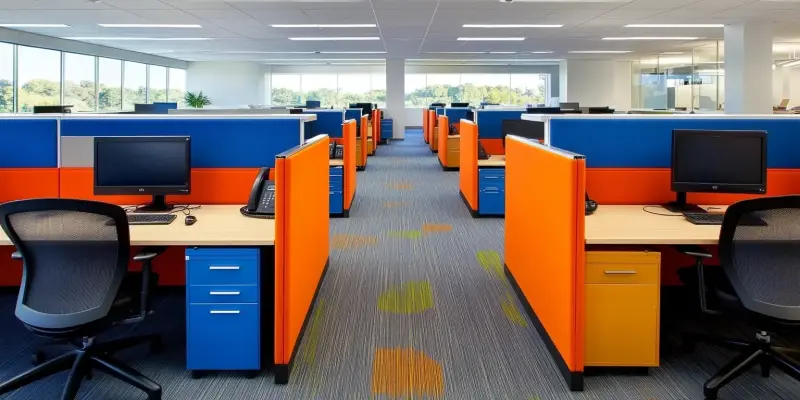As companies across the globe adapt to post-pandemic realities, the concept of hybrid workspaces has gained significant traction.The movement away from traditional, assigned desks and large private offices towards more flexible and collaborative environments highlights a profound shift in workplace strategies. A substantial change is observable in CBRE’s workplace project benchmarking data, showing how traditional assigned seating has drastically fallen from 83% to 55%, while hybrid and desk-sharing models have surged from 12% to 36%. This transformation illustrates an increasing preference for flexibility and activity-based work environments, marking a new era in office design and functionality.
Despite this notable shift, numerous organizations still cling to outdated models, often neglecting the necessity for environments conducive to collaboration and activity-based work.One prominent trend is the rising employee-to-seat ratio, with over 60% of organizations now targeting a sharing ratio of 1.5 employees per desk. This ratio underscores a strategic move to maximize space utilization effectively. Additionally, individual spaces have seen a significant reduction, dropping from 51% to 40%. Currently, workstations measuring between 35 and 49 square feet are becoming the norm, now comprising 64% of workspaces.This shift away from larger private offices, which have sharply declined from 16% to 4%, reflects changing leadership preferences and more dynamic space utilization within modern offices.
Evolution of Workspace Design
In recent years, the emphasis on creating collaborative and teamwork-oriented spaces has fueled a renaissance in office environments. Organizations now prioritize designs that enhance employee engagement, networking, and socialization. These contemporary workspaces integrate visually appealing and functional elements that foster a sense of community and innovation. Yet, enclosed meeting rooms remain a preferred choice over open areas, as employees seek visual and audio privacy.This trend highlights a need for maintaining some traditional elements while embracing new collaborative concepts. Furthermore, the use of private focus areas has surged, being 21% higher than the use of open workstations.This increase signifies a growing demand for quiet and secluded zones where employees can concentrate without interruptions.
Transformation in organizational priorities extends to developing and integrating amenities designed to address wellness and community needs.Modern offices now feature town hall spaces with bleachers, quiet rooms, library-like zones, and lactation facilities. The allocation for amenity spaces has modestly increased from 11% to 17%, reflecting a balanced approach towards enhanced employee satisfaction.Full-service restaurants and cafes remain the most prevalent workplace amenities, followed by free parking, wellness spaces, multi-purpose spaces, and lactation rooms. These amenities not only attract and retain a hybrid workforce but also create a more engaging and gratifying office experience.
Fostering Employee Well-Being and Productivity
Organizations are increasingly acknowledging the importance of employee well-being by incorporating ergonomic furniture, noise-reduction strategies, and flexible work arrangements.These elements aim to cultivate a healthier, happier, and more productive workforce. In parallel, a notable increase in co-working spaces has emerged as a significant trend, offering vital support for companies managing growth, uncertainty, and accommodating a distributed workforce.More than 40% of medium-sized companies are planning to either maintain or expand their use of flexible office spaces. In contrast, a smaller percentage of larger companies, about 17%, are planning to reduce their utilization of these spaces.The evolving landscape underscores the necessity for organizations to remain agile and responsive to the changing needs of their workforce. The strategic integration of co-working spaces presents opportunities for innovation, networking, and collaboration across various industries.These spaces often feature advanced technological infrastructures and state-of-the-art amenities, further enhancing productivity and work experience. Consequently, companies that adapt to these hybrid workspace models are better positioned to navigate the complexities of the modern business environment while fostering growth and resilience.
Conclusion: Future Considerations for Hybrid Workspaces
As businesses worldwide adjust to post-pandemic realities,hybrid workspaces have become increasingly popular. Moving away from traditional, assigned desks and large private offices, contemporary workplaces now emphasize flexibility and collaboration.This trend is evident in CBRE’s workplace project benchmarking data, reflecting a significant drop in traditional assigned seating from 83% to 55%, while hybrid and desk-sharing models have risen from 12% to 36%. This shift highlights a growing preference for flexible, activity-based work environments, signaling a new era in office design and functionality.However, many companies still cling to outdated models, often ignoring the need for spaces that foster collaboration and activity-based work. A key trend is the increase in the employee-to-seat ratio; over 60% of organizations now aim for a sharing ratio of 1.5 employees per desk.This approach aims to maximize space utilization effectively. Furthermore, individual workspaces have decreased from 51% to 40%. Workstations now typically range between 35 and 49 square feet, comprising 64% of contemporary workspaces.Private offices have sharply declined from 16% to 4%, reflecting changing leadership preferences and a trend toward more dynamic office use.

